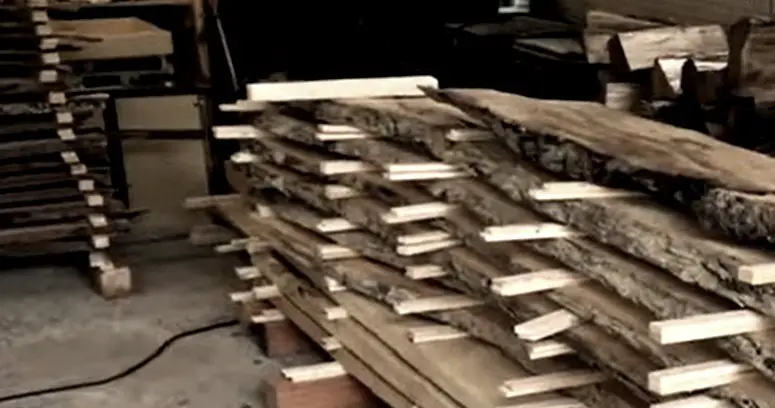
In this post we’ll be discussing 3 methods of drying wood with air. They include: 1. strictly air drying, 2. strictly kiln drying, and 3. air drying followed by kiln drying.
1. Strictly Air Drying
With air drying there is virtually no control of the temperature, relative humidity or speed of the air passing through the timber stacks.
The rate of drying is therefore dependent on all the vagaries of the local climate and can vary between practically zero on a calm, damp day to quite fast enough to cause surface checking during dry, windy weather.
In comparatively high humidity conditions, air drying is a slow process. Times taken to reach 20-25% moisture content vary from 2 or 3 months to 1 or 2 years in high humidity, depending upon the species and size of the timber.
With air drying, wood cannot be dried below its equilibrium moisture content and this will vary depending on the atmospheric conditions.
So, except in unusually hot and dry weather, the lowest moisture content obtainable is around 16-17%; air drying alone is not sufficient for timber intended for most interior uses in Europe, Japan or N. America where a moisture content of between 8 and 12% is required.
In air conditioned buildings moisture contents of about 12% should be anticipated.
2. Strictly Kiln Drying
In contrast to air drying a modern conventional drying kiln provides temperature control and a steady and adequate flow of air over the timber surface.
The air flow rate and direction is controlled by fans and the temperature and relative humidity of the air can be adjusted to suit the species and sizes of timber being dried.
It is thus possible to make full use of the increase in drying rate which can be achieved by raising the temperature to the maximum value which a particular timber species can tolerate without excessive degrade.
At the same time, the relative humidity can be controlled so that the moisture gradients in the wood are not steep enough to cause surface checking.
The same principles apply to the use of heat pump kilns except these recover and re-use a proportion of the energy which in conventional kilns is lost during the drying process when the warm, damp air is vented.
In addition to the advantages of more rapid drying and limitation of degrade, the ability to control drying conditions in a kiln means that it is possible to achieve timber moisture contents suitable for specific uses.
The direct costs of kiln drying are much higher than those of air drying for they include the capital costs of the equipment and the cost of fuel, electricity and supervision.
These costs are partially or wholly offset by the reduction in stock level.
3. Air Drying Followed by Kiln Drying
Kiln drying tends to become uneconomical when the species and size of timber being dried require long kilning times.
Therefore, with material taking more than about 4 or 5 weeks to kiln dry from green it will often be more economical to air dry the timber to about 25-30% moisture content before completing the drying in a kiln.
The economic advantage of this approach may be lost, however, if the layout or lack of handling facilities necessitates dismantling the air dried stack and re-piling for the kiln drying phase.
Also with some species, the amount of splitting and checking which occurs during air drying in the dry season can be excessive.
